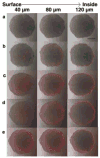Nanopreparations to overcome multidrug resistance in cancer
- PMID: 23973912
- PMCID: PMC3840079
- DOI: 10.1016/j.addr.2013.08.004
Nanopreparations to overcome multidrug resistance in cancer
Abstract
Multidrug resistance is the most widely exploited phenomenon by which cancer eludes chemotherapy. Broad variety of factors, ranging from the cellular ones, such as over-expression of efflux transporters, defective apoptotic machineries, and altered molecular targets, to the physiological factors such as higher interstitial fluid pressure, low extracellular pH, and formation of irregular tumor vasculature are responsible for multidrug resistance. A combination of various undesirable factors associated with biological surroundings together with poor solubility and instability of many potential therapeutic small & large molecules within the biological systems and systemic toxicity of chemotherapeutic agents has necessitated the need for nano-preparations to optimize drug delivery. The physiology of solid tumors presents numerous challenges for successful therapy. However, it also offers unique opportunities for the use of nanotechnology. Nanoparticles, up to 400 nm in size, have shown great promise for carrying, protecting and delivering potential therapeutic molecules with diverse physiological properties. In this review, various factors responsible for the MDR and the use of nanotechnology to overcome the MDR, the use of spheroid culture as well as the current technique of producing microtumor tissues in vitro are discussed in detail.
Keywords: Combination therapy; Multidrug resistance; Nanopreparations; Spheroid culture.
© 2013 Elsevier B.V. All rights reserved.
Figures






References
-
- Hung LW, et al. Crystal structure of the ATP-binding subunit of an ABC transporter. Nature. 1998;396(6712):703–7. - PubMed
-
- Yuan YR, et al. The crystal structure of the MJ0796 ATP-binding cassette. Implications for the structural consequences of ATP hydrolysis in the active site of an ABC transporter. J Biol Chem. 2001;276(34):32313–21. - PubMed
-
- Higgins CF. ABC transporters: from microorganisms to man. Annu Rev Cell Biol. 1992;8:67–113. - PubMed
-
- Schneider E, Hunke S. ATP-binding-cassette (ABC) transport systems: functional and structural aspects of the ATP-hydrolyzing subunits/domains. FEMS Microbiol Rev. 1998;22(1):1–20. - PubMed
-
- Litman T, et al. The multidrug-resistant phenotype associated with overexpression of the new ABC half-transporter, MXR (ABCG2) J Cell Sci. 2000;113(Pt 11):2011–21. - PubMed
Publication types
MeSH terms
Substances
Grants and funding
LinkOut - more resources
Full Text Sources
Other Literature Sources

